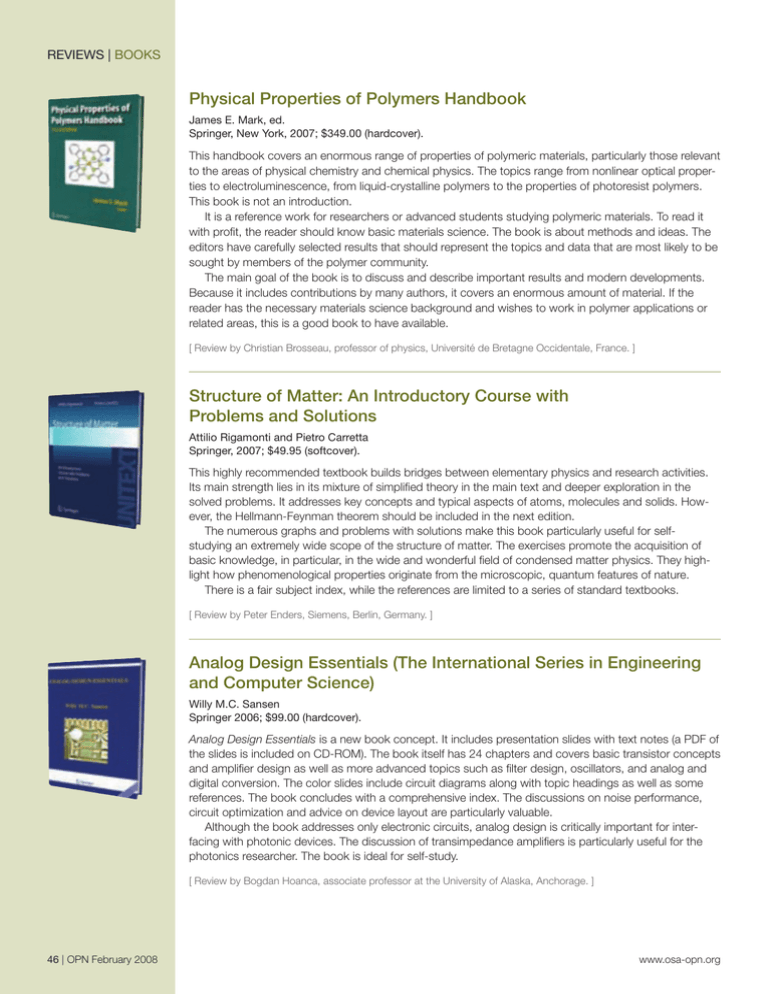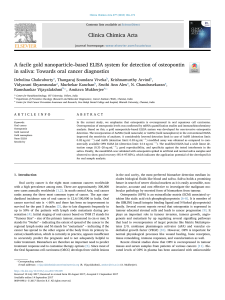Physical Properties of Polymers Handbook Structure of Matter: An
advertisement

REVIEWS | BOOKS Physical Properties of Polymers Handbook James E. Mark, ed. Springer, New York, 2007; $349.00 (hardcover). This handbook covers an enormous range of properties of polymeric materials, particularly those relevant to the areas of physical chemistry and chemical physics. The topics range from nonlinear optical properties to electroluminescence, from liquid-crystalline polymers to the properties of photoresist polymers. This book is not an introduction. It is a reference work for researchers or advanced students studying polymeric materials. To read it with profit, the reader should know basic materials science. The book is about methods and ideas. The editors have carefully selected results that should represent the topics and data that are most likely to be sought by members of the polymer community. The main goal of the book is to discuss and describe important results and modern developments. Because it includes contributions by many authors, it covers an enormous amount of material. If the reader has the necessary materials science background and wishes to work in polymer applications or related areas, this is a good book to have available. [ Review by Christian Brosseau, professor of physics, Université de Bretagne Occidentale, France. ] Structure of Matter: An Introductory Course with Problems and Solutions Attilio Rigamonti and Pietro Carretta Springer, 2007; $49.95 (softcover). This highly recommended textbook builds bridges between elementary physics and research activities. Its main strength lies in its mixture of simplified theory in the main text and deeper exploration in the solved problems. It addresses key concepts and typical aspects of atoms, molecules and solids. However, the Hellmann-Feynman theorem should be included in the next edition. The numerous graphs and problems with solutions make this book particularly useful for selfstudying an extremely wide scope of the structure of matter. The exercises promote the acquisition of basic knowledge, in particular, in the wide and wonderful field of condensed matter physics. They highlight how phenomenological properties originate from the microscopic, quantum features of nature. There is a fair subject index, while the references are limited to a series of standard textbooks. [ Review by Peter Enders, Siemens, Berlin, Germany. ] Analog Design Essentials (The International Series in Engineering and Computer Science) Willy M.C. Sansen Springer 2006; $99.00 (hardcover). Analog Design Essentials is a new book concept. It includes presentation slides with text notes (a PDF of the slides is included on CD-ROM). The book itself has 24 chapters and covers basic transistor concepts and amplifier design as well as more advanced topics such as filter design, oscillators, and analog and digital conversion. The color slides include circuit diagrams along with topic headings as well as some references. The book concludes with a comprehensive index. The discussions on noise performance, circuit optimization and advice on device layout are particularly valuable. Although the book addresses only electronic circuits, analog design is critically important for interfacing with photonic devices. The discussion of transimpedance amplifiers is particularly useful for the photonics researcher. The book is ideal for self-study. [ Review by Bogdan Hoanca, associate professor at the University of Alaska, Anchorage. ] 46 | OPN February 2008 www.osa-opn.org Bio-MEMS Technologies and Applications Wanjun Wang and Steven A. Soper, eds. CRC Press, N.Y.; $129.95 (hardcover). This book addresses the applications of microelectromechanical systems (MEMS) in biology and biomedicine. Bio-MEMS is represented by a large category of MEMS devices, such as microfluidic components, sensors and even a lab-on-a-chip, all of which can be used to monitor, manipulate or process biological or biomedical processes. The book is divided into three parts, each of which is written by an outstanding scientist in this new research field. The first part is focused on fabrication techniques for bio-MEMS, such as LIGA, nanoimprinting and hot embossing. The second is dedicated to microfluidic devices, such as micropumps, micromixers or microfabricated devices for sample extraction or cell manipulation. The third part describes sensing techniques for bio-MEMS applications, and includes important issues, such as MEMS for drug delivery, DNA analysis, single-cell and single molecule analysis. The book is very carefully edited and the basic concepts are clearly explained. It is a must for researchers working at the cutting edge of engineering, physics and biology, because it introduces the reader in an easygoing way to the basic concepts of a new area of research. [Review by Mircea Dragoman, National Research and Development Institute in Microtechnology, Bucharest, Romania.] The opinions expressed in the book review section are those of the reviewer and do not necessarily reflect those of OPN or OSA. XFCTBMFT!LFPQTZTDPN XXXLFPQTZTDPN 10th sary iver ann ,&014:4 The Light Touch SPIDERLITE Multiple Ports High Power Fiber Amplifiers Keopsys offers a wide range of high power amplifiers for CATV broadcastand and FTTx fiber transmission applications. Up to 32 ports Several power configurations: 32x17 dBm, 16x20 dBm, ... Low Noise Figure Highly reliable Low power consumption Low analog signal distorsion Wide operating temperature range OPN February 2008 | 47


